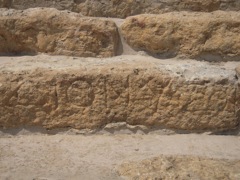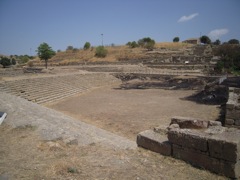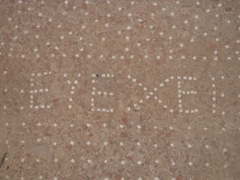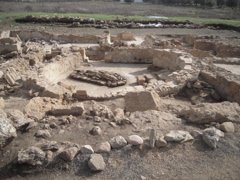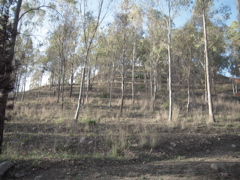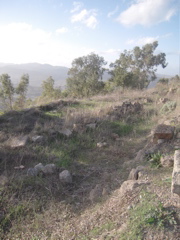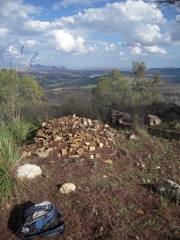In the center of the island is the remarkable site of Morgantina, a Hellenistic town high in the hills, with a huge agora and well preserved house plans that gives you a great idea of what such a town would have been like — stoas, temples, administrative buildings, shops, fountains, etc. Part of what makes the site so useful is that it is no longer inhabited — it is just an archaeological dig. Moreover, the site is presented exceptionally well, with the finds preserved nearby in the wonderful museum of Aidone — also presented exceptionally well.
The theater is among the impressive remains:
One step boasts that it was dedicated to Dionysus by a resident.
In the center of the agora is a space that looks like a place for an assembly
The private houses have some impressive floors. Here the kitchen floor from the House of the Doric Capital offers (grammatically incorrect) best wishes to those who enter — perhaps the work of a barely Greek-literate craftsman — or the commission of a not so Greek-literate Sicel before 211, or Spaniard or Roman after…:
To the west are some very early Greek baths, currently being studied and excavated by Sandra Lucore:
But to the east there is another hill and it was the site of the archaic citadel that was destroyed in the middle of the fifth century by the leader of the Sicel revolt, Ducetius. The site is much less impressive than the Hellenistic site when you first see it:
But in the context of this program and the work we do on early Greek-Sicel interaction, it offers some very interesting monumental architecture that attests to the selective adoption by Sicels of certain Greek practices, as well as the presence of some Greeks in this Sicel settlement. It was also within the Deinomenid orbit.
This structure is where an impressive crater by the red-figure pioneer was found:
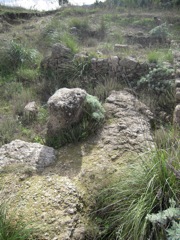 And on the somewhat inaccessible lower plateau, there are impressive remains of some monumental structures — temples, walls — along with piles of architectural terracottas:
And on the somewhat inaccessible lower plateau, there are impressive remains of some monumental structures — temples, walls — along with piles of architectural terracottas:


